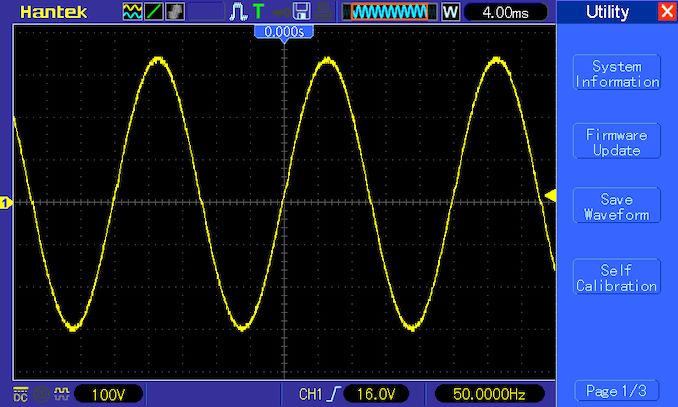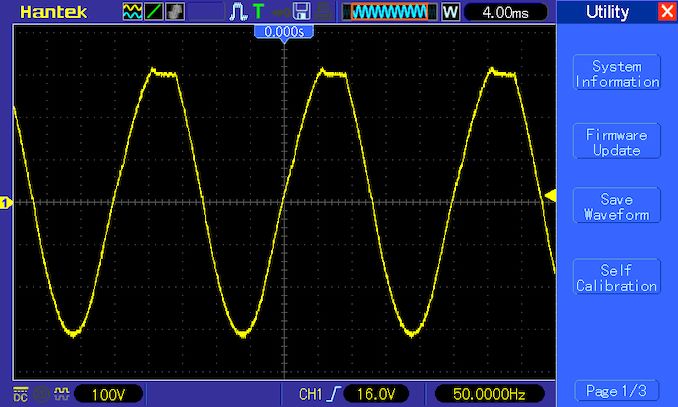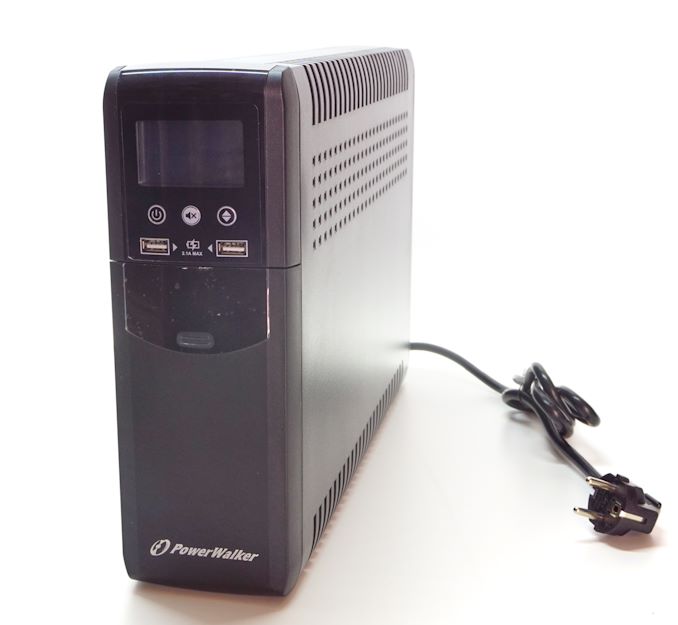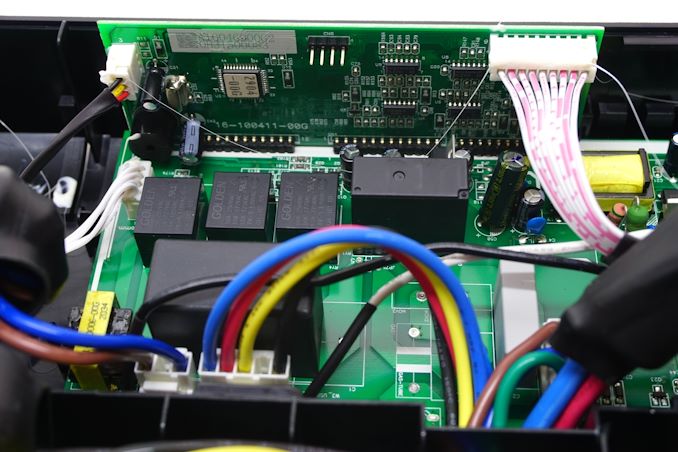The PowerWalker VI 1500 CSW UPS Review: Trying For True Sinewave on a Budget
by E. Fylladitakis on April 13, 2022 8:00 AM EST- Posted in
- Cases/Cooling/PSUs
- UPS
- PowerWalker
- BlueWalker
- 1500VA
Testing
Putting the PowerWalker VI 1500 CSW to the test, the basic electrical figures of the UPS are acceptable, with the unit delivering the performance it promises. When it operates on battery power, the voltage output is exactly 224 V RMS regardless of the load. There are minor frequency variations but these are exceptionally small. The transfer time is relatively high, yet not out of the manufacturer’s specifications. Though it also seems to significantly depend on the load, which should not be happening to this extent.
| UPS Load Performance | |||||
| 10% | 25% | 50% | 75% | 100% | |
| Voltage Output (Vrms) | 224 | 224 | 224 | 224 | 224 |
| Frequency (Hz) | 50.05 | 50 | 50 | 49.95 | 50 |
| Transfer Time (ms) | 6.1 | 7.6 | 7.8 | 7.6 | 8.9 |
The fan of the unit outputs 41.6 dB(A) once it is running. By UPS standards this is not a very high figure, but it's certainly not a very comfortable amount of noise, either. The downside here is that the PowerWalker VI 1500 CSW requires nearly 10 hours to fully charge its batteries once they are completely empty, which could be a problem with the unit installed in a living room or, worse, bedroom.
In our load testing, we've found that the battery runtime of the PowerWalker VI 1500 CSW is even better than advertised. These figures are achieved with its batteries fully charged and while they are new.
The PowerWalker VI 1500 CSW boasts true sinewave output, and our testing confirms this. Under load, our instruments showing a nearly-perfect sine wave with the unit running on battery power – but only while the load is low. Once the load reaches 50% (450 Watts) the deformation of the sine wave becomes apparent. It also becomes deformed abnormally, with only the positive peaks getting chopped, meaning that it is only one half of the circuitry failing to perform. At nearly 90% load (800 Watts) the waveform is nearly square, with both peaks heavily chopped, suggesting a massive number of harmonics. This will definitely not be healthy for any device that requires a pure sinewave input, such as APFC circuitry and AC motors.
Conclusion
The PowerWalker VI 1500 CSW is a UPS designed to combine a high output and true sinewave capability at a retail price affordable for most home consumers. At around €180, it currently retails for half of the price reputable manufacturers ask for their equally powerful true sinewave products, making it a very enticing deal.
The build quality of the PowerWalker VI 1500 CSW is better than one would expect from a product retailing at this price. Its parts are coming from reputable manufacturers and the unit is very well assembled. The design is dated but that is not inherently wrong – it just means the unit isn't geared to deliver the kind of top-of-the-line performance that more recent designs can provide.
When it comes to performance, the PowerWalker VI 1500 CSW performs, for the most part, according to its specifications. The trade-offs and issues become apparent when a closer look is taken, revealing that its electrical performance leaves a lot to be desired. The unit fails to maintain a true sinewave output when the load exceeds about 25% of its rated capacity, which could lead to serious issues if an application requires a true sinewave input. To be sure, for most home applications like modern PCs and TVs, this will not be a significant issue, as they take measures against harmonics and the expected load is usually but a fraction of the unit’s maximum output. However, if the unit needs to run at its maximum output or to drive loads that are very sensitive to harmonics, such as electric motors or older PCs, it could have damaging results to the equipment.
Ultimately, for users who are currently on the market for a UPS that is expected to mostly run at low loads, such as for safeguarding a single PC and its peripherals, the PowerWalker VI 1500 CSW is a fine choice. The UPS offers a clean enough electrical feed to meet the needs of a PC (or similarly switching power supply device), and it has the headroom to handle the stress if the power outage happens when the system is very heavily loads (e.g. while gaming). However, it is very clearly a device that was designed against engineering trade-offs to bring down costs for its target market. So, due to its inability to maintain a clean true sinewave output, we cannot recommend it for sensitive applications, and prospective users will want to be especially careful analyzing the sensitivity of their equipment to harmonics before purchasing it.
















107 Comments
View All Comments
casteve - Wednesday, April 13, 2022 - link
Thanks for the review. A couple of features I look for:- is it passive or fanned/what's the fan noise level? (thanks for that)
- can alerts be silenced? High electronic beeping really freaks out my dog.
- when it's running on batteries or in AVR mode is the output ugly enough to cause a PC's PSU to make ugly noises?
- Is there a master/slave mode where slave outputs turn on/off when the UPS detects load/no-load conditions on the master? A really useful function on older APC units. Put the PC on the master and the monitor and audio amp on the slave.
mode_13h - Wednesday, April 13, 2022 - link
> can alerts be silenced? High electronic beeping really freaks out my dog.Although there's frequently a front panel button to disable the beeps, you'll often find that even models without this will allow you to disable the beep via software, after connecting to its USB or serial port. You can also get some useful and interesting information that way, as well.
That reminds me of a funny story about an older model of APC Smart-UPS. It has a 9-pin serial port, on the back. So, I install the APC Power Chute software and connect it to my PC. As soon as I complete the cable connection, the USP goes *dead*. I unhook it, and it turns back on (I forget if I also had to hit the power button... probably I did). Then, I check the docs and see that the friggin' thing turns out to have a nonstandard pin-out! WTH?? Now I get why their newer models with serial ports don't use a standard-looking 9-pin connector, but that's just *bad*.
tl;dr - Make sure to use the included cable, if you have an APC model with the 9-pin connector on the back!
mode_13h - Wednesday, April 13, 2022 - link
> Is there a masterI discovered this accidentally, when I turned off a co-worker's monitor as I was leaving the office, one Friday afternoon. I thought I heard something else turn off, but I thought nothing of it. After the next time, he figured out what was happening and changed which device was plugged into the master outlet.
I think I've seen some units with a button to disable this behavior. IMO, it should be disabled by default. I'd even previously *seen* the "Master" label, but had no idea what it meant.
watersb - Wednesday, April 13, 2022 - link
I am really pleased to see a UPS review the same level of expertise as the remarkable power supply articles. Excellent!espressomakerdeluxe - Wednesday, April 13, 2022 - link
Brilliant idea! Please do rack mount units. Pretty please.croc - Thursday, April 14, 2022 - link
Excellent article, expertly written by a knowledgeable author I hope that future articles will include graphs / pictures with all reviewed models included. Such a database might become dated, but that also allows us to see how far we've come.One thing I did notice was the clipping of the output waveform of this particular model under load. Without comparisons, it is difficult for the average person to really understand what that means for his equipment, so feel free to continue to comment in an unbiased manner. Hope that AnandTech is paying you enough that you can avoid 'sponsership'.
Kamus - Thursday, April 14, 2022 - link
All of these companies are going to be driven out of business by the "solar generator" market soon.Those guys are making very cheap LFP battery powered, pure sine wave inverters at very competitive prices. (at least compared to an UPS)
The only thing holding back those "solar generators" is that a lot of them don't switch fast enough yet, but honestly, even with the current 15ms switching times I would take them over a lead acid UPS.
philehidiot - Thursday, April 14, 2022 - link
Sounds like this might do the job for me. I want it for powering a couple of guitar amps strapped to a motorcycle to play offensive music at people who have glued themselves to roads in order to "protest" insulation. They never do it in winter, only when it's warm, which is superb for battery life and riding.Tomatotech - Saturday, April 23, 2022 - link
Excellent idea. I'm deaf, if you find me glued to a road please play your music nice and loud so that I can enjoy it properly.Alternately please ask your MP to ask the Govt to follow the recommendations of its own expert advisors and spend some money on insulation. If it had done this when the advice first came out, the UK would be in a much better position with regard to being able to reject buying Russian oil and gas. As it is, your taxes are going towards giving billions to *both* sides of a bloody and genocidical war. I think that's worth protesting about.
DigitalFreak - Thursday, April 14, 2022 - link
Question is, are these reviews going to be frequent or only one or two per year?